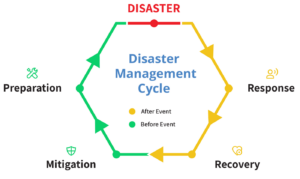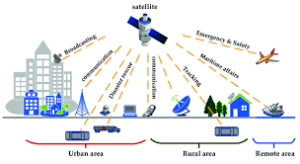Introduction to AI and its Role in Disaster Management
Imagine a world where technology can predict disasters before they strike, saving lives and minimizing damage. Artificial Intelligence (AI) is stepping into this crucial role, revolutionizing disaster prediction and management. As natural calamities continue to challenge communities globally, the integration of AI provides a ray of hope. This innovative approach harnesses vast amounts of data to forecast events like hurricanes, earthquakes, and floods with remarkable accuracy.
Understanding the intricate patterns in nature has never been easier. With AI’s ability to analyze real-time information from various sources—satellite imagery, social media alerts, weather reports—it opens up new avenues for preparedness and response strategies. The potential impact is staggering: fewer casualties and faster recovery times.
Join us as we explore how AI is reshaping the landscape of disaster management today!
The Benefits of Using AI in Disaster Prediction
 AI significantly enhances our ability to predict disasters. Its advanced algorithms analyze vast amounts of data in real-time, identifying patterns that humans might overlook.
AI significantly enhances our ability to predict disasters. Its advanced algorithms analyze vast amounts of data in real-time, identifying patterns that humans might overlook.
This capability leads to earlier warnings for severe weather events like hurricanes or floods. Communities can prepare more effectively when they receive timely alerts.
Moreover, AI-driven models improve resource allocation during emergencies. By predicting where disasters will strike, emergency services can position assets strategically and save lives.
Another advantage lies in the analysis of past incidents. Machine learning techniques evaluate historical data to refine predictions further, offering insights into potential future scenarios.
Effective communication is also a key benefit. AI tools help disseminate important information quickly across various platforms, ensuring people stay informed and safe during crises.
Case Studies: How AI has Helped in Disaster Prediction and Management
 AI has made significant strides in disaster prediction and management, with various case studies showcasing its potential.
AI has made significant strides in disaster prediction and management, with various case studies showcasing its potential.
In 2017, during Hurricane Harvey, IBM’s Watson analyzed weather patterns and social media data. This provided real-time insights that allowed emergency services to allocate resources more effectively. The result? A faster response time that saved lives.
Similarly, researchers at the University of California utilized machine learning algorithms to predict wildfires. By examining historical fire data alongside climate variables, they developed a predictive model. This enabled local authorities to issue timely evacuations before flames encroached on communities.
Another fascinating example comes from Japan’s earthquake preparedness systems. AI-driven models analyze seismic activity patterns, helping officials anticipate tremors and plan accordingly. Such proactive measures significantly reduce risks associated with these natural disasters.
Each case underlines AI’s transformative power in managing crises efficiently while enhancing safety for affected populations.
Challenges and Limitations of AI in Disaster Management
Despite its promise, AI faces significant challenges in disaster management. Data quality is a critical concern. Algorithms rely on accurate and timely data to make predictions. Incomplete or outdated information can lead to poor decision-making.
Another limitation lies in the complexity of natural disasters themselves. Each event has unique characteristics that are difficult to model accurately. This uncertainty can hinder effective response strategies.
Furthermore, technology access remains uneven across regions. Many developing areas lack the infrastructure needed for advanced AI systems, creating disparities in disaster readiness and response capabilities.
Ethical concerns also arise when utilizing AI for crisis situations. Decisions made by algorithms may not account for human factors or community needs, potentially causing harm instead of helping.
Adapting regulations and guidelines will be essential as we move forward with integrating AI into disaster management frameworks while addressing these limitations responsibly.
Ethical Considerations
As AI becomes more integrated into disaster prediction and management, ethical considerations emerge as a crucial topic. The use of advanced algorithms raises questions about data privacy. How much personal information is collected? Who has access to it?
There’s also the issue of accountability. If an AI system fails to predict a disaster accurately, who is responsible? Is it the developers, the organizations using the technology, or even governmental agencies?
Bias in algorithms presents another challenge. Training data may reflect societal biases that lead to unequal responses in different communities. This can exacerbate vulnerabilities rather than alleviate them.
Transparency in AI processes is essential for building public trust. Communities need clarity on how decisions are made and what data informs those choices.
Addressing these ethical dilemmas requires ongoing dialogue among stakeholders—developers, policymakers, and affected communities—to ensure equitable solutions that prioritize human safety above all else.
The Future of AI in Disaster Management
The future of AI in disaster management is bright and filled with potential. As technology continues to evolve, we can expect more sophisticated algorithms capable of predicting disasters with even greater accuracy.
Advancements in machine learning will enhance real-time data analysis. This means quicker responses to emerging threats and better allocation of resources during crises. Imagine drones equipped with AI scouting areas post-disaster, identifying survivors or assessing damage instantly.
Collaboration between governments and tech companies could lead to innovative solutions tailored for specific regions prone to certain natural disasters. Community involvement might also rise as people leverage apps powered by AI for early warnings.
Furthermore, ethical deployment will be crucial. Ensuring that the benefits reach vulnerable populations without compromising their safety or privacy must be a priority as new systems are developed.
With ongoing research and commitment from various sectors, we stand on the brink of an era where intelligent machines significantly transform how we prepare for and respond to calamities.
Conclusion
The integration of AI into disaster prediction and management is reshaping how we approach natural calamities. By harnessing vast amounts of data, machine learning algorithms can analyze patterns that human analysts may overlook. This capability enhances our predictive accuracy, allowing for more effective resource allocation and timely responses.
As demonstrated through various case studies, the role of AI has proven invaluable in situations ranging from predicting hurricanes to managing wildfires. These applications showcase not only the technology’s potential but also its effectiveness in saving lives and minimizing damage.
However, it’s essential to recognize the challenges that accompany this technology. Limitations such as data quality and algorithm biases need addressing to ensure reliable outcomes. Furthermore, ethical considerations around privacy and decision-making must be at the forefront as we rely more on automated systems.
Looking ahead, advancements in AI promise even greater improvements in disaster management strategies. As researchers continue refining these technologies, communities worldwide stand to benefit significantly from enhanced preparedness and response capabilities.
Embracing AI could lead us towards a future where disasters are managed more efficiently than ever before. The intersection of technology with humanitarian efforts paves a new path forward—one filled with hope for safer environments amidst inevitable challenges.










